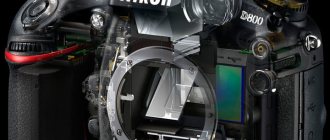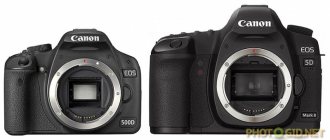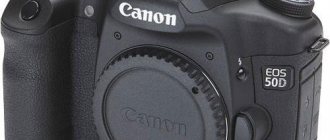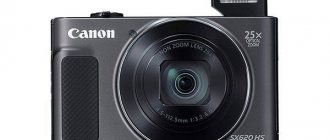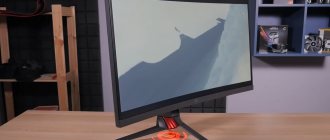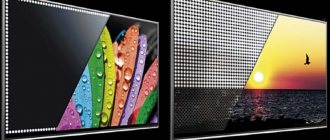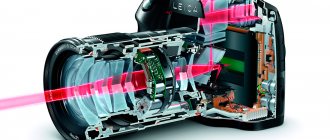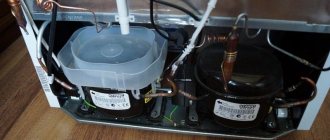Which one is better to buy? DSLR or mirrorless? These questions are often asked by beginners who decide to take up photography. The dilemma remains relevant, no matter how many new models of photographic equipment are released.
Therefore, in order to make the right choice, let’s find out what is better - a SLR camera or a digital one, and also consider the purposes for which each of them is used and what their distinctive features are.
What kind of camera do you have?
Mirror
0%
Mirrorless
100%
Voted: 1
What is the difference between a DSLR and a digital camera?
The main difference between a DSLR camera is the presence of a mirror, which is at an angle of 45 degrees and reflects the light flux into the viewfinder. Autofocusing is carried out using a special sensor unit. The image in the viewfinder is reflected as it really is.
Mirrorless cameras do not have a viewfinder, but if they do have one, it is only an electronic one. Control is entrusted more to the electronics; there is no ability to focus and adjust exposure, since the digitized image is immediately displayed on the display.
SLR cameras always consist of two parts - the lens and the body (body). Only the new generation of mirrorless models boast detachable lenses.
A few words about SLR and digital cameras
What does a SLR camera mean? This is a camera that works on the following principle: light passing through the lens is directed to a diaphragm, which regulates the volume of light flux. After this, the light hits the mirror, from which it is reflected and redirected to the viewfinder. The viewfinder and gripper lenses are one piece. In addition, such devices use a special digital matrix designed to record images.
To understand what a “DSLR” is, you need to understand how a SLR camera differs from a digital one. The second one is very popular due to its low cost, compactness and ease of use. But, in the viewfinder of a regular digital camera, the image enters through a separate small lens, which is most often placed above the main one.
DSLR cameras are valued by more “advanced” users. Thanks to sensitive lenses and various shooting modes that are manually adjusted, professional units can take amazing pictures that are more than just a regular “photo” for a social network.
In addition, SLR cameras consist of several parts: attached optics (lenses) and a “body”. In terms of technology, DSLRs have come a long way and have become thinner and smarter devices. The quality of the photographs will undoubtedly differ from those taken with a point-and-shoot camera. There is excellent detail, shooting speed, bright colors, the ability to blur, focus and much more.
Therefore, to the question: “Which is better, DSLR or digital camera?” There is only one correct answer - it’s better to buy an inexpensive DSLR than to spend money on an expensive point-and-shoot camera, especially since a smartphone can handle the functions of the latter perfectly.
And now a little about the characteristics that you need to pay attention to when choosing a high-quality SLR camera.
Camera specifications
When you buy a DSLR or mirrorless camera, you are purchasing a whole system with a set of different characteristics. It is important to know them in order to navigate the abundance of goods. Here are the most important of them:
- The size of the matrix is the main unit of the camera, a digital analogue of photographic film. The chip consists of millions of light sensors that convert sunlight into an image. The larger the matrix, the more light it captures and the noise in the photo becomes less.
- Noise is a photographic defect that occurs in low light. Represents chaotically located colored dots. You can get rid of digital noise using an editor, but this entails a loss of sharpness.
- ISO – light sensitivity of the matrix. The higher the value is set, the wider the possibilities for shooting in the dark. This increases the amount of noise. Optimal ISO values are 50, 100, 150. On DSLRs the range of values is large (up to 100,000). Soap dishes have up to 400.
- Shutter speed is the time for which the lens blades open when the shutter is released. Measured in seconds - 1/13, 10, 1/4000. The more it is open, the more light enters the matrix. In point-and-shoot cameras, the shutter speed is set automatically by the camera. In DSLRs you can set the shutter speed yourself.
SLR cameras, unlike point-and-shoot cameras, have about 50 characteristics. Not all of them are useful, as the manufacturer indicates. Consider the list of the most important parameters of DSLRs:
- Aperture is a value that regulates the lens opening by changing the diameter of the light beams passing through it. The smaller the aperture value, the larger the hole diameter. The parameter affects the depth of field. If you set higher values, the sharpness will be greater.
- White balance – adjusts the color temperature of a photo. Allows you to customize the light source.
- Focus point is the point at which the rays reflected from the image converge. There is an automatic mode where all available focus points are used. Single point mode allows the photographer to independently select the point on which the image will be focused.
- Color histogram – the tonal range of an image. The tool allows you to adjust brightness and color before and after creating an image.
Advantages and disadvantages
Dry terminology will only allow you to better learn about the internal structure of cameras, but will not help much in choosing. The best way to decide is the pros and cons of each photographic equipment. Let's look at them in tables.
SLR Cameras
| pros | Minuses |
| Shooting speed. The shutter release of an amateur DSLR in daylight is 2 seconds. Expensive models take a photo in less than a second in the dark. | Carcasses weigh at least 400 grams. Whale lenses weigh about 300 grams. Such dimensions can no longer be stuffed into a pocket or handbag. |
| The optical viewfinder allows you to see the picture in real time as it really is. | You need to know how to use a SLR camera. If you just point and press the shutter, the photograph will not differ from the image of a point-and-shoot camera. |
| Ergonomics. DSLRs have buttons, wheels, and a monochrome display for quick settings. | The price of professional photographic equipment starts from 50 thousand rubles. Amateur ones will cost about 20 thousand rubles. This is 7 times more expensive than a soap dish. |
| With phase detection autofocus, you can adjust focus in a few seconds. In this case, you do not need to look away from the viewfinder. | Changing lenses is not the fastest process. When carrying out the rearrangement, we must not forget that dirt, dust and moisture should not get on the matrix. |
| The device turns on in 1-1.5 seconds. This is especially important when you need to take a quick photo. | |
| DSLRs always use rechargeable batteries that can last 2-3 days of continuous shooting, since they use a viewfinder that consumes virtually no energy. | |
| In the low-cost segment, the camera will provide more features than a point-and-shoot camera for the same price. | |
| All models are equipped with protection from moisture and dust, and professional equipment is completely waterproof. | |
| Ability to save images in RAW format. The photo is saved in the form in which we see it in the viewfinder. At the same time, in additional programs such as Photoshop, it becomes possible to adjust exposure and color rendition. | |
| Large selection of lenses for different purposes. | |
| The size of the resulting images. This is an important moment for sales and publication in print media. |
Structure of a SLR camera
Mirrorless cameras
| Advantages | Flaws |
| Lightweight - soap dishes weigh approximately 300 grams. There are models that fit in your pocket and weigh no more than 200 grams. | Compact soap dishes owe their size to a small matrix and the absence of a mirror, which affects image quality. |
| High resolution video shooting (4K). Few DSLRs can boast such shooting quality. | Slow and automatic autofocus. The photographer has no way to adjust the focus where he needs it. |
| Built-in WiFi module. This is convenient when you need to transfer photos to your phone or computer. | The absence of a mirror affects long exposure times compared to a DSLR, especially in the dark. If your hand twitches even a little at this time, the entire image will blur. |
| It’s convenient to carry a mirrorless camera with you so you can quickly pull it out and take a photo. | Old soap dishes run on batteries that constantly need to be changed or charged. New models are produced with batteries, but their operating time is much shorter, since the screen consumes a lot of energy during operation. |
| Almost all new soap dish models are shockproof and waterproof. | Ergonomics at a low level. To set up the camera, you will have to take a break from the image and delve into the settings. |
| Affordable price. The most expensive mirrorless camera can only be compared in cost to an entry-level DSLR camera. | We put weak lenses on soap dishes that do not have long focal lengths. And only expensive new generation mirrorless cameras have the option of replacement. In addition, the choice of interchangeable lenses is very small. |
Diagram of a mirrorless camera
Design and principle of operation of a SLR camera
This type of camera has a more complex structure and a different operating principle. Compared to the “compact”, they have expanded functionality.
@Pixabay
At the same time, the plus and minus of such cameras is the presence of a mirror device. Such devices cannot be dropped, but preferably carried in special cases.
The design of the gadget consists of parts:
- body - carcass or body;
- kit lens.
The latter consists of a large number of lenses arranged parallel to each other. The design also includes a diaphragm - a part that controls the amount of light that falls on the product’s matrix.
@Creative Youth Media - blogger
The image obtained using a “DSLR” is formed as follows:
- The light beam passes through the lens shutter.
- The beam then hits the diaphragm.
- After its passage, the light enters the translucent mirror. Here it is divided into two separate streams. The first passes through a series of parallel mirrors and is sent to a convex lens.
- The next step is processing the beam with a pentaprism. Here an image is formed, which is sent to the LCD screen of the viewfinder (located on the back of the device). The pentaprism flips the frame, giving it a position familiar to the human eye.
- The second stream of light is sent to a focusing device consisting of many electronic sensors. They determine whether the image is in focus and trigger the lenses if necessary. The latter rotate several degrees, thanks to which the photographer gets a high-quality result.
- At the end, when both processed streams meet and the operator is satisfied with the shot, it’s time to press the shutter. At this time, the system of mirrors moves back, and the light hits the matrix on which the image is formed.
Which camera is better - DSLR or mirrorless?
In the battle of mirrorless cameras versus DSLR cameras, the second option loses a little in terms of shooting quality. However, if the device is used to take home photos and print in small formats, there is not much difference.
The main thing in choosing is to focus on needs. If you want to experiment and study the art of photography, then make a choice in favor of SLR photographic equipment. But a soap dish will be better able to quickly capture the moment.
Size is also an important criterion. It’s always convenient to carry a mirrorless camera with you, but for a DSLR you’ll need a case or extra space in your bag.
So it's impossible to say which will be better. The main thing is to choose a camera that will be convenient and understandable to the owner.
